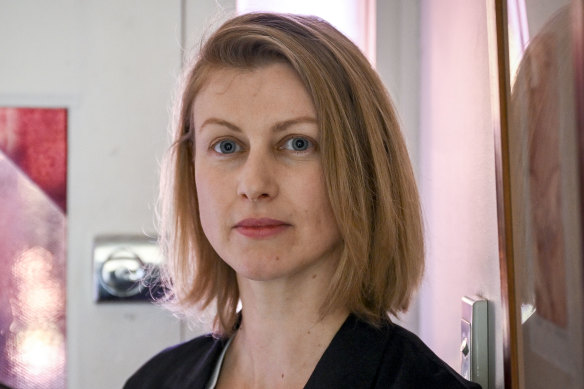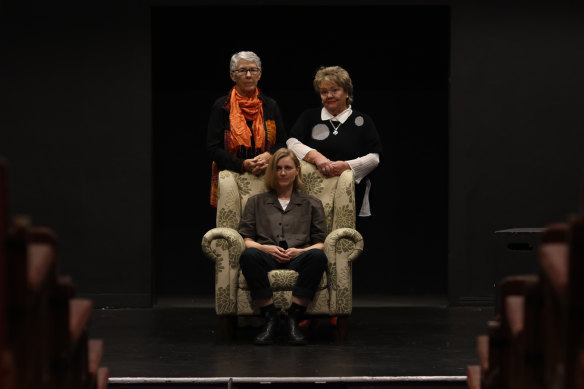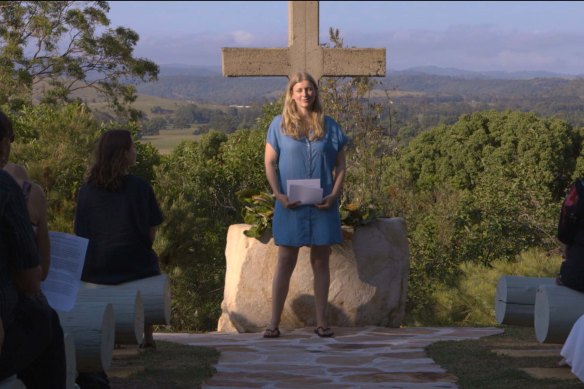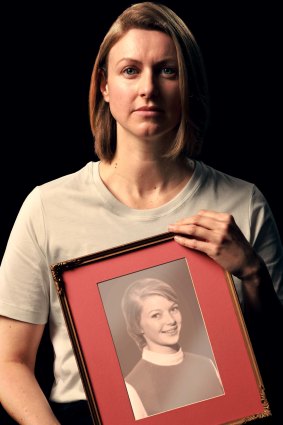Carolyn Stuckey was shot dead by her husband. He was then allowed to raise their three small children
By Wendy Tuohy
Kathryn Joy grew up dreading the question, “Where is your mother?”
“I didn’t want to have to explain the whole situation,” says the 39-year-old Melburnian, raised, along with two elder brothers, by the father who had shot their mother dead.

Kathryn Joy, pictured, was a baby when their mother, Carolyn Stuckey, was shot dead.Credit: Eddie Jim
“The truth is, my dad killed my mum,” says Joy. It was in January 1985 and Carolyn Joy Stuckey, 32, was a loved school teacher living in the New South Wales town of Lismore. Kathryn was just three months old at the time.
As a child, Joy would not have been able to explain why the three young children present in the home when their mother died were handed back to live with her killer. Allan Stuckey, who spent just 22 months in jail for shooting his wife in the abdomen and head with a bolt-action rifle, said almost nothing to the children.
A jury had accepted Stuckey’s defence that he was “provoked” because his wife was having an affair with a man from her local amateur theatre group. Stuckey – who had called police, telling them he shot Carolyn – was cleared of murder and convicted of the lesser charge of manslaughter.
Though he had monitored Carolyn by hiring a private detective, Stuckey was described by the trial judge as “undoubtedly at all times a man of exceptional character and obvious good standing in the community”, who had controlled himself well before snapping.

Kathryn Joy (seated) sought out the close friends of Carolyn Stuckey (Vicki Sheaffe, left. and Jill Brodie) to understand what happened. They are pictured in the Lismore theatre where Carolyn appeared in a play with the man who would become her lover.
One of the strongest memories Joy has of their childhood and adolescence is the “silence” that surrounded it.
“There weren’t photos, there weren’t stories, her name was never mentioned,” says Joy, now a family violence researcher at Melbourne University. “The story that I was told was she had done this awful thing – he snapped, and then he had killed her. [It was] really framed as this sort of accident.”
Carolyn’s body was handed back to Stuckey, who had it hastily cremated. Her friends have since told Joy they feared the consequences in Lismore should they raise what happened.
“By the time I was old enough to understand what went on, I had been told, both overtly and indirectly, that that’s over and done with, it was in the past, we don’t need to bring that up any more,” says Joy, who uses they/them pronouns and has dropped the surname Stuckey in favour of the middle name shared with their mother.
Joy is telling their story to show what happens to the many children bereaved by family violence in Australia, and to piece together Carolyn’s story and why certain decisions were made about her children’s care.
“I just did an informal count of the number of children bereaved by domestic homicide in the first four months of this year, and it was 34 children,” says Joy, who appears in the new documentary Revealed: KillJoy, eight years in the making, about the killing of Carolyn and the aftermath.
“And that was an underestimate … really basic, just what I could find. Thirty-four children in four months lost their mother to domestic homicide, and when I think about the implications of that and how little support we have for children, that to me is just devastating.”
The lifelong effects of the trauma on Joy have included believing they would die at the same age as Carolyn – “32 years, nine weeks and six days” – and experiencing regular, shocking nightmares from which they wake screaming, terrified and hyperventilating.

Kathryn Joy held a belated memorial for slain mother Carolyn Stuckey in an open-air cathedral near the family’s then home town of Lismore.
Joy was struck while doing research for the documentary by how much emphasis was placed during Allan Stuckey’s sentence on what would best serve him, rather than the children or justice for Carolyn. Joy was four when they were returned to his custody and he returned to work in a pharmacy.
“I just kept thinking, how does anyone think that the children … would benefit from going back to live with my father in the house [where] he killed our mother?” Joy says. “It’s so baffling to me that that would be seen as good for us. More than anything, I just felt a real sense of: this was not about us.
“This was about what was in my dad’s best interests, and that’s pretty devastating, especially given I know what came next. I had to live with the impact of that decision; so to go back and hear those [judge’s] words about my father getting back to his life and his family as soon as possible was just so shocking.”
It helped inspire Joy’s advocacy for other child survivors at a time when leaders in Australia’s child protection and family violence sectors are calling for children to be regarded as victim-survivors in their own right, who require individual support responses.
Melbourne University research suggests 1000 Australian children have lost a parent to domestic homicide in the past decade.
Professor Kate Fitz-Gibbon, chair of Respect Victoria and an internationally recognised family violence researcher, says specialist responses for child survivors are “critically needed” because children are often “invisible in the systems where they seek help”.

Kathryn Joy holds an image of their mother, who was killed in the family home by Joy’s father.
“They have been responded to merely as an extension of a protective parent as opposed to being recognised as a victim-survivor in their own right,” she says. “Policy and practice reform to build whole-of-system specialist and child-centred responses is urgently needed.
“For far too long these individuals have been invisibilised and have been left alone to navigate the unimaginable challenge of recovering from the killing of a parent by another parent.”
Cathy Humphreys, a Melbourne University social work professor and co-chair of the Melbourne Alliance to End Violence Against Women and Their Children, says there is a growing number of Australian children and young people whose mothers have been killed by partners.
“These gross acts of violence leave children with trauma that resurfaces across their lifetimes, and the service system is ill-prepared to respond to these children,” she says. There is no tracking or data kept about how many children are left behind after a parent’s death as a result of family violence.
“We cannot change what we don’t measure. The child victims whose mothers (and sometimes fathers) have been killed are a tragic example of this silence in the data,” Humphreys says.
“These children have no specific rights. Many are dealt with informally through family networks, some of which are entirely supportive of the killer … There is no community sector organisation specifically funded to respond with skill, sensitivity and expertise to these children.”
National Children’s Commissioner Anne Hollonds agrees with Joy that childhood experiences of violence are a strong predictor of later-life problems.
“If we are serious about ending violence against women, we need to get serious about addressing violence in childhood. This is the hidden prevention opportunity that has been ignored because child safety and wellbeing is not a national priority.”
Joy hopes the documentary will help galvanise more action for child survivors who have little say in what happens to them.
“Children are absent in those decisions,” Joy says. “And they are impacted forever because of that.”
Revealed: KillJoy will be streaming on Stan (owned by Nine, publisher of this masthead) from September 8.
If you or anyone you know needs support, you can contact the National Sexual Assault, Domestic and Family Violence Counselling Service on 1800RESPECT (1800 737 732), Lifeline 131 114, or Beyond Blue 1300 224 636, or call Kidshelpline 1800 55 1800.
The Morning Edition newsletter is our guide to the day’s most important and interesting stories, analysis and insights. Sign up here.